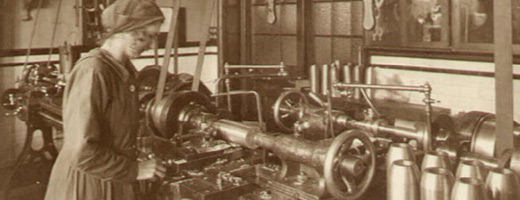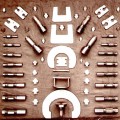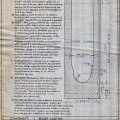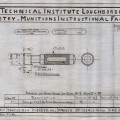Loughborough’s Instructional Factory for the Ministry of Munitions
27 June 2014

One year into the First World War, in September 1915, the little Technical Institute in Loughborough, which provided day and evening classes in science, technology and art for local people, appointed a new Principal.
This came just at the time when the newly established Ministry of Munitions, set up in response to the shell crisis, was in urgent need of trained workers for the wartime munitions factories.
The new Principal of the Technical Institute, Herbert Schofield, already had very definite views on the method of training of munitions workers and immediately offered the Institute’s workshops for this purpose. Having secured a contract to produce 18-pounder HE shells, he set about converting and extending the workshops and raising funds to buy suitable machine tools.
After only three months the Institute workshops were ready to receive the first batch of trainees. They were to be instructed according to Schofield’s novel scheme of ‘training on production’, whereby they learned their craft by actually turning out the shell cases and other material needed for the war effort.
The first trainees, all women, arrived in January 1916 for two week training courses. Groups of up to 30 women received about 40 hours training a week. Double shifts were used and some local women took the course in the evening or during the night. Later courses lasted between two weeks and six months and discharged disabled soldiers and men unfit for service also became trainees.
The factory was run strictly on shop lines with trainees required to clock in and out. New workshops were built and equipped and within a year Loughborough had become the third largest technical college in the country training munitions workers, the majority of them women.
The trainees worked as shell turners, gauge makers, tool setters, fitters, and aircraft woodworkers. The fuselage and wings for the Avro 504K, for instance, were made by women trainees in the old Congregational Chapel in Orchard Street and transported to the Brush Factory where the aircraft were manufactured.
After competing an unpaid probationary period, women received 4½d to 5½d an hour and men 6d to 9d. They went on to work in munitions factories across the Midlands. Nor was the welfare and social side of the Factory neglected. A Lady Superintendent was appointed and a canteen, club room and surgery provided for the trainees.
We know a little about the munitions girls. One of the first was a Miss Jackson who learned how to use micrometers and vernier callipers to make limit gauges. She then went to work at Laycock’s in Sheffield, in charge of 30 girls making aeroplane parts. Norah Brooks and her friend Edith Tillison came from Mansfield in 1918 and lodged in the Red House in Burton Walks, which had been acquired as a hostel for female trainees.
Forest View in Forest Road and Sunnyside in Park Road were also used to house trainees. Another girl, called Iris, lodged in a private house in Toothill Road while she completed a six week course making aeroplane wings. Afterwards she went to work in a factory in Peterborough.
By the end of the war, more than 2300 people, mostly women, had been trained at the Loughborough Instructional Factory.
Jenny Clark – Loughborough University Archives
You can see a copy of a 1918 booklet about the Instructional Factory here.


